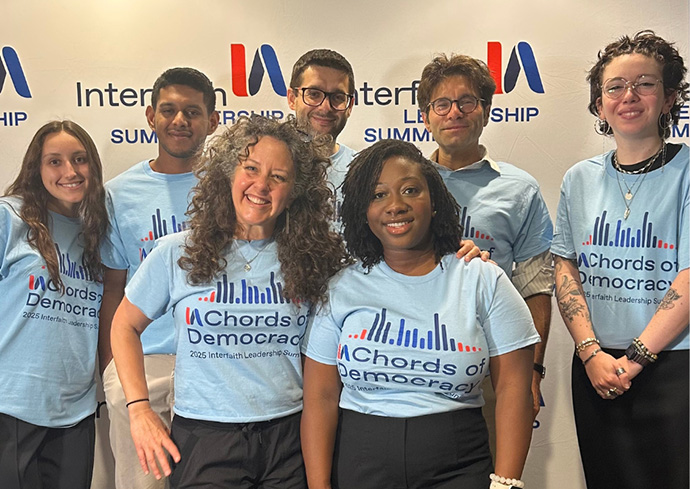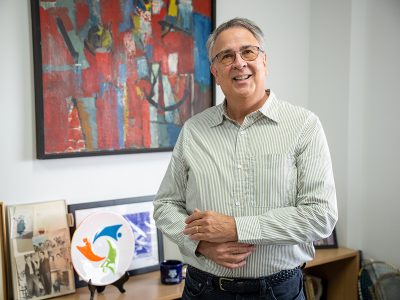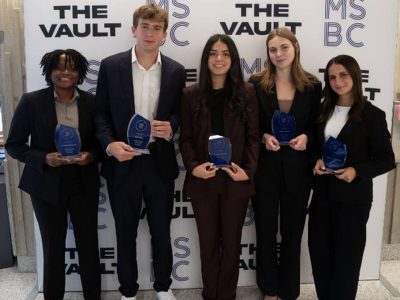Hendricks Chapel Chaplains, Staff and Students Attend Interfaith America Leadership Summit
A dedicated group of chaplains, students and staff from Hendricks Chapel attended the Interfaith America Leadership Summit in Chicago from Aug. 8-10. The multifaith cohort joined more than 700 participants to bridge divides and forge friendships across lines of religious and spiritual differences. Through the theme of “Chords of Democracy,” the summit was the largest gathering of interfaith leaders in the world for 2025.
Interfaith America, which was founded as Interfaith Youth Core (IFYC) in 2002, is based on the idea that “religious difference should serve as a bridge of cooperation rather than a barrier of division.” Through a research-backed approach, Interfaith America works on college campuses, in the corporate field and across civic spaces. The founder and president of Interfaith America, Eboo Patel, visited Syracuse University in February, where he met with campus leaders and participated in a public conversation in Hendricks Chapel with Vice President and Dean Brian Konkol.
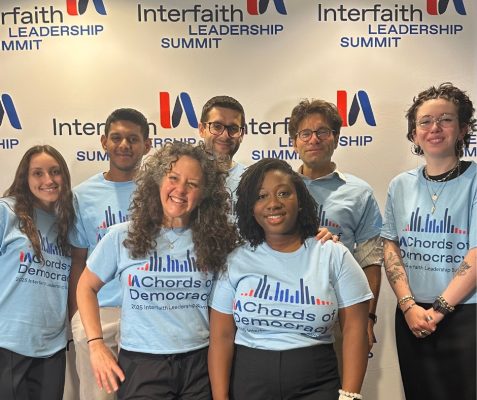
Building on two decades of experience as a partner to universities, the Interfaith America Leadership Summit has grown into the largest gathering of students and educators with a commitment to American religious pluralism. Through the support of generous donors, Hendricks Chapel sent eight representatives to the 2025 summit: Imam Amir Durić, assistant dean for religious and spiritual life; Rabbi Natan Levy, campus rabbi at Syracuse Hillel and Jewish chaplain; Dara Harper, communications manager; Kaleya Scott, engagement coordinator; and students Omar Mohammed ’27, Ronit Hizgiaev ’28, Aubrie Methven ’26 and Sofiya Ivanova ’27.
For Durić, who is currently one of Interfaith America’s Interfaith Innovation Fellows, one of the most valuable aspects of the summit was the opportunity to gather with student leaders and professionals of diverse backgrounds who share a deep commitment to building bridges in our pluralistic society. “Being in a space where every person’s story was honored reminded me of the Qur’anic call to come to ‘know one another’ (Qur’an, 49:13),” says Durić. “The summit was not just about exchanging ideas, but about forming genuine connections that inspire us to work together for the common good.”
The summit was filled with opportunities for a variety of people to connect, discuss and ponder important questions. Panels and plenaries provided overarching concepts, while training “tracks” provided participants with opportunities to delve deeper into specific ideas. With over 700 attendees, the training tracks proved to be useful opportunities to engage through smaller groups and discuss challenging topics. Among the summit tracks included “Practical Tools for Addressing Tension and Repairing Divides,” “Building Pluralism Through Student Interfaith Leadership,” “Bridging the Gap” and more.
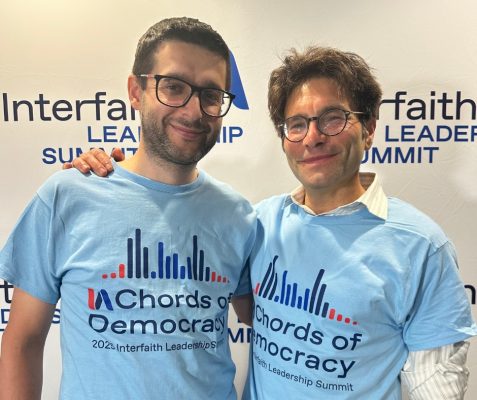
Levy, who recently joined the Syracuse University campus community, attended a track on addressing tensions and repairing divides. “In our track, we learned a beautiful technique on how to inquire about another person’s data input; the key experiences and information that they were using to interpret their point of view,” says Levy. “This method offered a new perspective on why others were coming up with conclusions so different than my own; they were simply beginning with a different starting point, with different input.”
In addition to the formal portions of the summit, the team from Hendricks Chapel also shared time together in more informal settings, which provided opportunities for relationship building, idea sharing and program planning. When some enjoyed dinner together at a local restaurant, Mohammed, of the Muslim Student Association, and Hizgiaev, of Syracuse Hillel, embraced the opportunity to discuss what ideas and initiatives they would like to promote for the coming academic year.
“I truly enjoyed seeing our Jewish and Muslim Syracuse students absorbed in conversation and sharing interfaith project ideas for the year ahead. These seemingly small dialogue moments give me a great sense of hope, because they come from the students themselves, and therefore signify a future of bridge-building,” says Levy.
Hizgiaev, an international relations major in the Maxwell School of Citizenship and Public Affairs and College of Arts and Sciences, attended the student interfaith leadership track and thoroughly enjoyed the panels and plenary sessions. “My experience throughout the summit was one to remember. From interfaith event simulations to networking galore, there was never a moment when I wasn’t immersed in the teachings this experience had to offer. I left the summit feeling this strong sense of urgency about what we were learning during sessions—stories of polarization, collaboration and resilience,” she says.
She was especially moved by a comment from one of the panelists: “Faith can provide something deeper than politics.” She says she wishes that these words could be played on a loudspeaker for all the world to hear. “Our society has become sundered to the point of not seeing humans for who we are, for the qualities we possess, for the beauty in our religious practices,” reflects Hizgiaev.
After days of discussions and community-building, the Interfaith America Summit concluded, and the movement of building bridges and friendships continues at Syracuse University. “My prayer is that we carry the spirit of this gathering into our campuses, communities, and the wider world,” says Durić.
